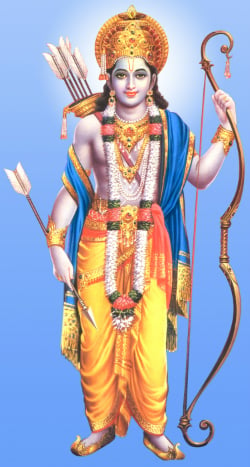
Vijayadashami (Dussehra)
One derivation of the word Dussehra is from dashhara. ‘Dash’ means ten and ‘hara’ means defeated. Nine days before Dussehra, in the nine days of Navaratri, all the ten directions are saturated with the female deity’s (devi’s-Shakti) energy. ‘Shakti’ has control over creation in all the ten directions (dikbhav), attendants (gan), etc. That is why this day is known as Dashhara, Dussehra, Dassera, Vijayadashami, etc. This is one amongst the three and a half auspicious period (muhurts) of the year. This falls on the tenth day (dashami) of the bright fortnight of Ashvin. The immersion of the Navaratri (female deity) is done on the ninth day (navami) or the tenth day. Four rituals namely crossing the territory (Simollanghan), worship of the Shami tree (Shamipujan), worship of the deity Aparajita (Aparajitapujan) and worship of instruments (Shastrapuja) should be performed on this day.
Rituals to be performed on Vijayadashami
1. Crossing the territory (Simollanghan)
In this ritual the territory of a village is crossed in the north-east direction in the third part (‘prahar’) of the day, that is in the afternoon. And one should stop at a Shami or Apta tree.
2. Worship of the Shami tree (Shamipujan)
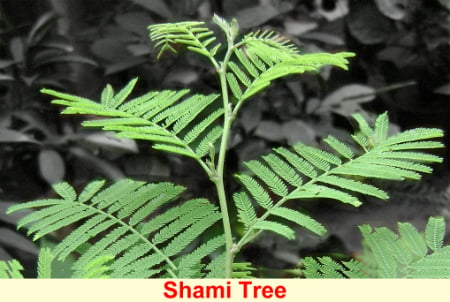
The Shami tree is worshipped with the recitation of the following prayer.
शमयते पापं शमी लोहितकण्टका । धारिण्यर्जुनबाणानां रामस्य प्रियवादिनी ।।
करिष्यमाणयात्रायां यथाकाल सुखं मया । तत्र निर्विघ्नकर्री त्वं भव श्रीरामपूजिते ।।
Meaning : The Shami tree cleanses sins. Its thorns are reddish in colour. It is Lord Rama’s favourite tree and in such a tree Pandavas hid their arms. O Shami, Lord Rama has worshipped you. I now embark upon my journey to victory. May you make it pleasant and free from obstacles.
3. Worship of the Apta or Ashmantak tree
The Apta tree is worshipped with the following mantra :
अश्मन्तक महावृक्ष महादोषनिवारण ।
इष्टानां दर्शनं देहि कुरु शत्रुविनाशनम् ।।
Meaning : O great Apta (also known as Ashmantak) tree, you are the one who overcomes great defects. Unite me with my friends and destroy my foes.
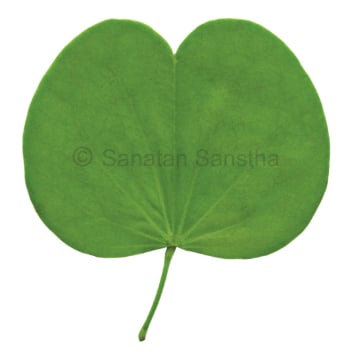
Then rice, a betelnut and a gold coin (copper coin as a variant) are placed near the roots of that tree. After circumambulating the tree, some mud from its base and some of its leaves are brought home. Leaves of the Apta are offered as ‘gold’ to God and friends. Conventionally, gold should be gifted by the young to the old. In Maharashtra, there is a custom of gifting gold to family members and friends on Dussehra. This has a historical significance too. After a military expedition, the brave Marathas would bring home the plundered booty from the enemy’s territory. These victorious warriors were welcomed by their wives or sisters with Arti (a prayer sung with the waving of a lamp). In return the warriors would give some gold ornaments from their plunder. The warriors then placed their loot before the deities in the temple of the house and offered obeisance to God and elders seeking their blessings. Nowadays, this is commemorated by distributing leaves of the Apta tree, symbolizing gold.
4. Worship of the deity Aparajita (Aparajitapujan)
During the worship of the Shami tree, eight petals (Ashtadal) are drawn on the ground and an idol of the deity Aparajita is placed on it and worshipped by chanting the following mantra :
हारेण तु विचित्रेण भास्वत्कनकमेखला ।
अपराजिता भद्ररता करोतु विजयं मम ।।
Translation : O deity Aparajita, You who adorn a necklace, a glittering golden girdle and who blesses devotees earnestly, bestow victory upon me.
In some places, this Aparajita-puja is also performed before leaving for the ritual of crossing the territory.
5 . Worship of instruments / weapons (Shastrapuja)
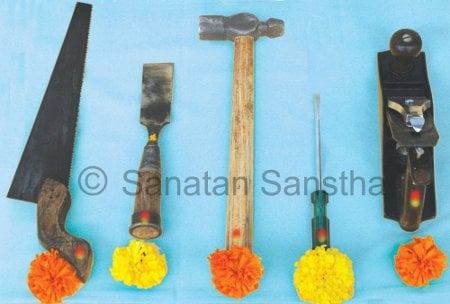
On this day soldiers and the feudal princes clean their weapons, arrange them in a row and worship them. Farmers and artisans too worship their respective implements or instruments. Some also perform this ritual on the ninth day of Navaratra.
The royal way of celebration
Since Dussehra is a festival of triumph, on this day special rituals have been recommended for nobles and kings. This is a festival signifying victory and valour. Before Arjun went into hiding (adnyatvas), he placed all his weapons in the hollow of the Shami tree. But on this day when the Kourav army was herding away King Virat’s cattle, Arjun pulled out his weapons from the Shami tree and confronted the army and defeated them. It is believed that Lord Ramachandra too slayed Ravana and emerged victorious on this day. To signify these events, this day has been named Vijayadashami. Actually this festival was celebrated even in ancient times. At that time it was a festival of the peasants. A peasant would celebrate it after bringing home his first monsoon harvest. During Navaratra, on the day of installation of the pot (ghatasthapana) nine types of food grains are germinated in the altar (sthandil). On the day of Dussehra the sprouted grains are pulled out and offered to the deities. In several places the main door of the house is decorated with sheafs of rice grains. This custom also depicts that it is a festival of the peasants. With the passage of time this festival became religious in nature and in the historical ages, it became a political one. (Ref: Bhartiya Sanskritikosh, Volume 4, Page no.319,320)
Importance of celebrating Vijayadashami
1. Vijayadashami teaches us to think about others
Vijayadashami is the festival of the Devi (Goddess) and Devi is the Deity of Shakti (Divine Energy). On Ashwin Shukla Pratipada, the Devi is invoked and is worshipped for 9 days. On the 10th day, Shami tree is worshipped for peace. To maintain peace everywhere, display of weapons, armour, military etc. is done and if there is any enemy, one must march to annihilate the enemy. After annihilating the enemy and establishing peace everywhere, gold should be distributed.
2. It is being celebrated since Tretayug
Shriram’s ancestor, King Raghu of Ayodhya, performed the Vishwajit Yadnya. He donated all his wealth and retired to a hut in a forest. Then, Sage Kautsa appeared before him and asked for 14 crore gold coins. King Raghu prepared to attack Deity Kuber, the Deity of wealth, to obtain his requirement. Deity Kuber showered gold coins on the Apta (Mountain Ebony) and Shami (Indian Mesquite) trees. King Raghu accepted only fourteen crore gold coins and his subjects took the rest. (Sage Kautsa and King Raghu represent the true Hindu culture ! What a contrast to today’s politicians and people who crave for wealth and worldly pleasures. – Editor)
3. Saraswatidevi is in unmanifest form this day
Saraswatitattva (Saraswati Principle) is in unmanifest seed form due to the creation of excess of sagun-bhav (Expressed spiritual emotion). Hence, on this day, Saraswatidevi is worshipped in Her active form.
4. Elimination of the Tama-component and distressing energy on this day
Spiritual science says that when Devitattva (Goddess Principle) is active, the process of elimination of Tamogun and distressing energy takes place at the sagun level and when Vishnutattva (Vishnu Principle) is active, elimination of Tamogun and distressing energy takes place at the nirgun level. On Vijayadashami, the tarak (Saviour) Devitattva is active with the Vishnutattva. With these Principles working together, besides the elimination of Tamogun and distressing energy, Priti develops in these Principles; hence, with Destruction, the task of Creation also takes place. The emission of Priti-enriched waves of welfare from the active Principles of Devi and Vishnu spread in the universe. This helps in activating the process of Creation and results in good crop yield, prosperity etc. Shri Lakshmi (Goddess of wealth, the consort of Shri Vishnu) works with Him to perform the task of Sustenance. Hence, Shri Vishnu takes the help of Shri Lakshmi in every Incarnation and both take human forms at the same time.
5. Shriramtattva & Hanumantattva and Vijayadashami that generates kshatravrutti
On Vijayadashami, tarak waves of Shriramtattva (Shriram Principle) and marak (Destroyer) waves of Hanumantattva (Hanuman Principle) combine. On this day, kshatrabhav (Attitude of a warrior) of the individual is awakened. By remembering Shriram and Hanuman on Vijayadashami, dasyabhakti (Devotion unto God as a servitor) is generated and the individual gets the benefit of taraktattva (Blessings) of Shriram.
On Vijayadashami, red (Shakti-form) and reddish brown (Waves of blessings generated due to dasyabhav) spring-like waves are active in the universe. Due to these waves, the Atmashakti (Energy of the soul) of the individual is awakened, which increases the leadership quality in the individual and helps in nurturing kshatrabhav.
On Gudhipadva, Saraswatidevi’s tarak form and
on Vijayadashmi, Mahasaraswatidevi’s marak form should be worshipped
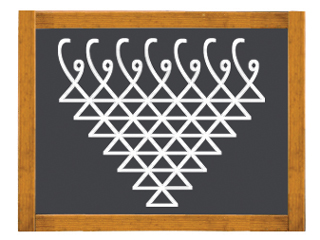 Saraswatidevi should be worshipped on Gudhipadva and Dussehra. On Gudhipadva, Saraswatidevi’s waves of taraktattva are active in the universe, while on Dussehra, Mahasaraswatidevi’s waves of maraktattva are active in the universe. Saraswatidevi is the Deity who gives direction to kriyashakti (Energy of action); hence, in the beginning of the Year She is invoked and worshipped so that She blesses us for the entire year. Saraswatidevi’s worship activates the jiva’s Brahmatej (Radiance of a Brahman). Every action performed on the strength of Brahmatej is conducive to the jiva’s spiritual progress. Worshipping Saraswatidevi on Gudhipadva activates the Shaktitattva in the waves related to Brahmatattva that are active in the universe, and they work for the jiva. The jiva’s mind becomes pure and sattvik as it comes in contact with these waves, and its Shaktitattva helps make the intellect sattvik. This makes it possible for the jiva to combine good thoughts with good actions.
Saraswatidevi should be worshipped on Gudhipadva and Dussehra. On Gudhipadva, Saraswatidevi’s waves of taraktattva are active in the universe, while on Dussehra, Mahasaraswatidevi’s waves of maraktattva are active in the universe. Saraswatidevi is the Deity who gives direction to kriyashakti (Energy of action); hence, in the beginning of the Year She is invoked and worshipped so that She blesses us for the entire year. Saraswatidevi’s worship activates the jiva’s Brahmatej (Radiance of a Brahman). Every action performed on the strength of Brahmatej is conducive to the jiva’s spiritual progress. Worshipping Saraswatidevi on Gudhipadva activates the Shaktitattva in the waves related to Brahmatattva that are active in the universe, and they work for the jiva. The jiva’s mind becomes pure and sattvik as it comes in contact with these waves, and its Shaktitattva helps make the intellect sattvik. This makes it possible for the jiva to combine good thoughts with good actions.
The jiva’s Kshatratej (Radiance of a warrior) is activated by worshipping Saraswatidevi’s maraktattva on Dussehra.
Read Sanatan’s Holy texts on Deities to generate faith in yourself and obtain maximum benefit !

 Message on Vijayadashami (Dussehra)
Message on Vijayadashami (Dussehra)